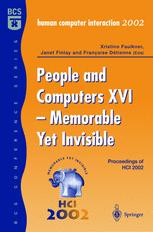

Most ebook files are in PDF format, so you can easily read them using various software such as Foxit Reader or directly on the Google Chrome browser.
Some ebook files are released by publishers in other formats such as .awz, .mobi, .epub, .fb2, etc. You may need to install specific software to read these formats on mobile/PC, such as Calibre.
Please read the tutorial at this link: https://ebookbell.com/faq
We offer FREE conversion to the popular formats you request; however, this may take some time. Therefore, right after payment, please email us, and we will try to provide the service as quickly as possible.
For some exceptional file formats or broken links (if any), please refrain from opening any disputes. Instead, email us first, and we will try to assist within a maximum of 6 hours.
EbookBell Team

5.0
98 reviewsFor the last 20 years the dominant form of user interface has been the Graphical User Interface (GUl) with direct manipulation. As software gets more complicated and more and more inexperienced users come into contact with computers, enticed by the World Wide Web and smaller mobile devices, new interface metaphors are required. The increasing complexity of software has introduced more options to the user. This seemingly increased control actually decreases control as the number of options and features available to them overwhelms the users and 'information overload' can occur (Lachman, 1997). Conversational anthropomorphic interfaces provide a possible alternative to the direct manipulation metaphor. The aim of this paper is to investigate users reactions and assumptions when interacting with anthropomorphic agents. Here we consider how the level of anthropomorphism exhibited by the character and the level of interaction affects these assumptions. We compared characters of different levels of anthropomorphic abstraction, from a very abstract character to a realistic yet not human character. As more software is released for general use with anthropomorphic interfaces there seems to be no consensus of what the characters should look like and what look is more suited for different applications. Some software and research opts for realistic looking characters (for example, Haptek Inc., see http://www.haptek.com). others opt for cartoon characters (Microsoft, 1999) others opt for floating heads (Dohi & Ishizuka, 1997; Takama & Ishizuka, 1998; Koda, 1996; Koda & Maes, 1996a; Koda & Maes, 1996b).